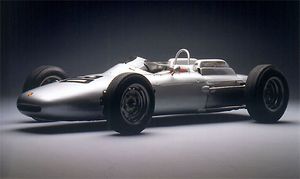.
Porsche 804

| |
| Porsche 804 | |
|---|---|
| Porsche | |
| aka | Porsche 804 F1 |
| Production | 1962 |
| Class | Formula One |
| Body Style | Single seater open cockpit racer |
| Length | 3600 mm |
| Width | {{{Width - type here}}} |
| Height | {{{Height - type here}}} |
| Wheelbase | {{{wheelbase - type here}}} |
| Weight | {{{Weight - you get the point}}} |
| Transmission | Five-speed manual, rear-wheel drive |
| Engine | Flat-eight, air cooled |
| Power | 180 bhp |
| Similar | Cooper T53 F1 Lotus 24 |
| Designer | {{{Designer (lead designer if it was a team effort)}}} |
The Porsche 804 was the car built by Porsche for the sole intention of entering Formula One in 1962. The 804 followed on from the single-seater versions of the Porsche 718, however was designed from the ground up with a brand new engine design.
The engine was designed by chief engineer Hans Mezger, and was an eight cylinder example, laid out in Boxer fashion. The total displacement was just under 1.5 liters. It was a dual overhead cam motor with two valves per cylinder and utilised four Weber twin-choke carburettors for breathing. The motor created about 180 bhp at 9,200 rpm, enough to keep up with the competition.
The Porsche team were quite competitive throughout the 1962 season, with Dan Gurney managing to secure two wins - one at the French Grand Prix, and the other in a non-championship race at Solitude, in Germany. However, even in 1962 Formula One was incredibly expensive, and Ferry Porsche decided to pull the plug on the programme, to focus upon Sportscar racing at the end of the year. This decision stemmed partly from the steep cost of F1 competition, but was also due to that fact that Porsche saw F1 as being of limited use to the company. The engine developed for the car was later used in a number of prototype 904s.
Formula One has never held much success for the Stuttgart concern - aside from the monumentally victorious McLarens fitted with Porsche-TAG engines in the 1980s. Porsche was tasked by Footwork to design its F1 engines in the early 1990s, but the cars failed to qualify for a single Grand Prix that season, and Porsche has not competed since.
